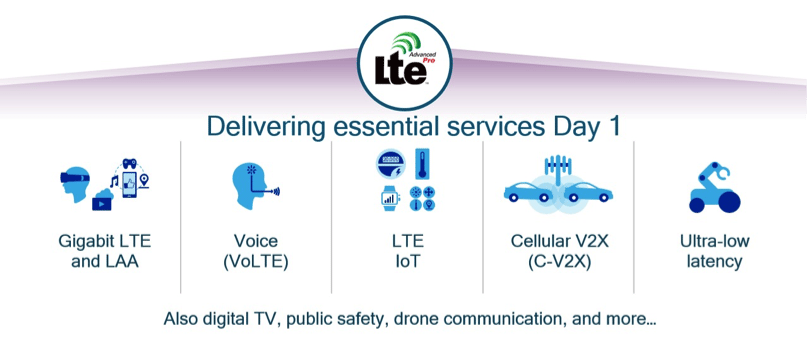Are you ready for 5G? Because it is closer than you may think.
In fact, we are getting our first glimpse of it today with the rich portfolio of technology advancements that are arriving with LTE Advanced Pro (3GPP Release 13 and beyond). We now have a taste of 5G fiber-like speeds with the recent launch of the world’s first commercial Gigabit LTE mobile device and network. We’re also pioneering technologies that extend LTE to unlicensed spectrum – completing the world’s first LAA and eLAA trials – allowing more mobile operators around the world to support Gigabit LTE. And it’s not just about faster speeds, we are also seeing broad ecosystem adoption of our LTE IoT Cat-M1/NB-1 modem that will establish the foundation for a massive 5G Internet of Things. For instance, we will soon be carrying out the first announced Cellular-V2X trial with Audi and others. C-V2X will play a critical role in the 5G-connected, more autonomous vehicle of the future. We’re also getting a glimpse at 5G mission-critical services with our cellular drone communication trial with AT&T and our FAA-authorized UAS Flight Center in San Diego.
Yes, Qualcomm is absolutely focused on inventing new technologies that will accelerate the development of 5G New Radio (aka 5G NR) – the global standard for a new, more capable 5G air interface – with trials starting during the second half of this year and wide-scale commercial deployments staring in 2019. In parallel, we are driving LTE to its fullest potential with a rich roadmap of LTE Advanced Pro technologies that will build upon the tremendous progress to date. It’s important to recognize that LTE Advanced Pro is not only providing a glimpse of 5G, it will also play an essential role in tomorrow’s 5G connected world. And the nascent 5G networks will rely heavily on ubiquitous LTE coverage. And that is why we are evolving LTE toward the 5G IMT-2020 requirements – pioneering many 5G technologies and use cases today. Being 5G-ready starts today with commercialization of LTE Advanced Pro technologies, which will provide many essential services to 5G from Day 1.

Driving the Gigabit LTE evolution
Now that Gigabit LTE has become a reality, many ask what’s next? Well, there is actually a strong evolution path in 3GPP Release 13 and beyond that will bring even better Gigabit LTE performance – new device categories have already been defined to support higher peak rates of 1.2 Gbps and 1.6 Gbps. Beyond faster speeds, there is also a plethora of new technology innovations that will further increase capacity, improve real-time performance, and deliver a more consistent user experience. Here is a quick look at three key technologies that will bring Gigabit LTE to the next level:
- Ultra-low latency: A new FDD and TDD design is expected to deliver significantly lower latency than today’s LTE networks. This will greatly improve performance by addressing protocol throughput limitations (e.g., TCP slow start), as well as provide a better user experience for real-time applications such as video calls.
- Better spectrum sharing: With Licensed Assisted Access (LAA) we extended LTE to unlicensed spectrum for downlink, which is a key enabler of Gigabit LTE. In 3GPP Release 14, we are enhancing LAA (eLAA) by extending this key feature to uplink carrier aggregation.
- Massive MIMO: The use of more antennas at the base station will enable 3D beamforming, which will increase network capacity and deliver more uniform data rates across the cell. 3GPP Release 14 will deliver enhanced support for up to 32-antenna ports, and makes significant improvements to beamforming accuracy and efficiency for multi-user MIMO.
Expanding the mobile ecosystem to new verticals
As pointed out earlier, LTE Advanced Pro is also driving innovations that expand into new use cases. Here are three key technologies that are refining the role of mobile networks in these new verticals:
- LTE IoT: 3GPP Release 13 introduced two new narrowband technologies, eMTC and NB-IoT, that more efficiently connect the IoT. These technologies are continuing to evolve in Release 14+ toward meeting IMT-2020 requirements as well as establishing the foundation for 5G massive IoT. Commercial LTE IoT network deployments are expected this year after commitments from major operators worldwide including AT&T, China Telecom, SK Telecom, Verizon and Vodafone.
- Cellular V2X: With the market heating up for autonomous vehicles, enabling vehicles to communicate with everything around them, even beyond the line-of-sight, has become more important than ever. LTE Advanced Pro is introducing C-V2X in Release 14, which will establish the foundation for safety use cases. New complementary capabilities such as sensor sharing are planned for Release 15+.
- Ultra-low latency services: With the new lower-latency FDD/TDD design that is coming in Release 14 and beyond, we are also opening doors to supporting new command-and-control use cases such as robotics and industrial automation. They will leverage the ubiquitous LTE coverage foundation, and pave the path to 5G’s ultra-reliable, low-latency services.
What to learn more? Join us for a webinar to understand the essential role of Gigabit LTE & LTE Advanced Pro in a 5G World, or check out our new LTE Advanced Pro website for the latest information and downloads.

